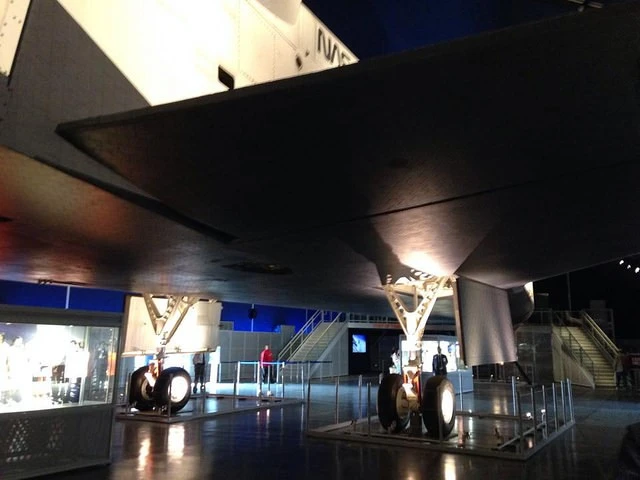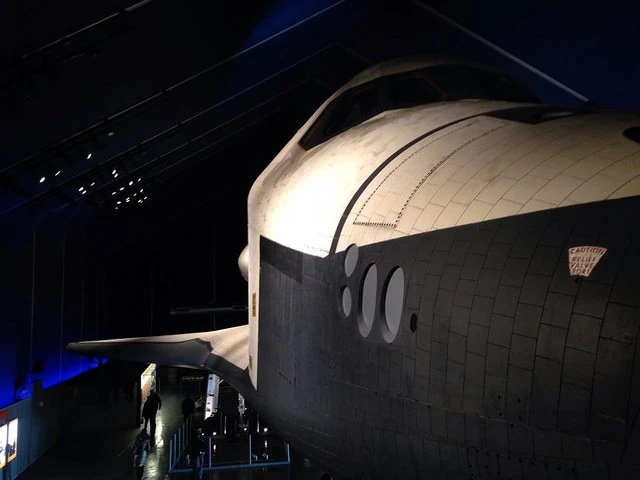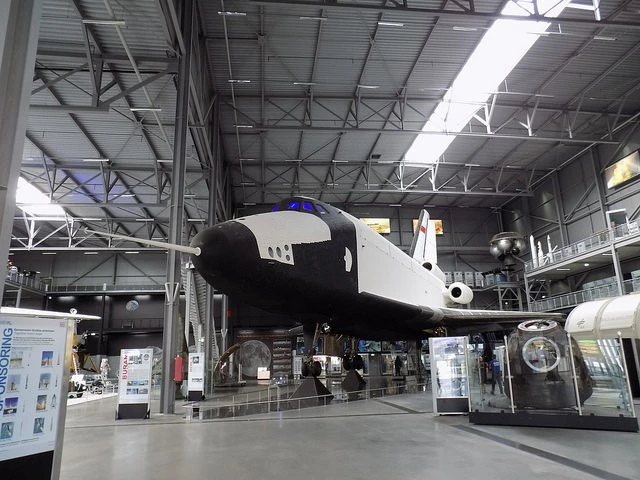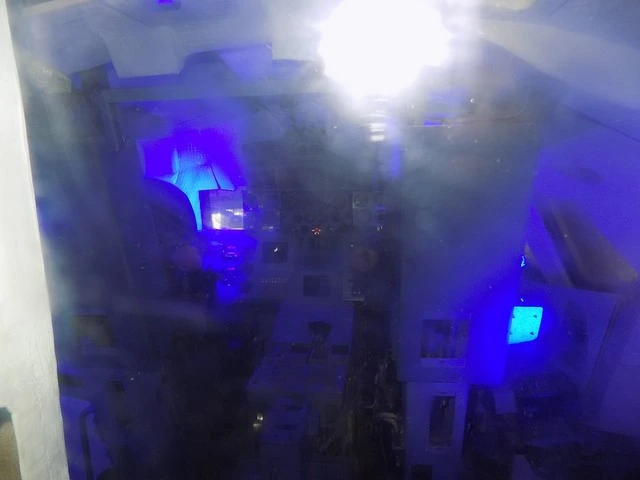I visit the Space Shuttle Enterprise and the Russian equivalent Buran – in two museums, half the world apart, to explore the similarities and differences of both craft.
Introduction to My Space Quest
Exploration on Earth has slowly declined over the last century. With much now known about the surface of our planet, explorers are turning their attention to the secret worlds in our vast oceans and inwards towards understanding what lies at the Earth’s core.
There are still places on Earth that are untamed, largely due to them being uninhabitable or difficult to reach. Many years ago, the rough and ready “Wild West” was dubbed the ‘final frontier’, with travel beyond our world being a very distant dream. That dream was realised in an incredibly short period of time. Between the age of gunslingers and outlaws and our first tentative efforts towards space, there are only a few decades.
For as long as man has looked to the sky, he has wondered what lay beyond. I am no exception to this; I have always wondered what is out there and as a keen explorer I have often pondered the thought of going into space. However, I have neither the money or a way to get there, and I’m sure as heck that NASA won’t be interested in my Double C award in my science GCSE.
No, the nearest I can get to space is flying on a passenger plane… or is it?
The Space Shuttle Enterprise (Not the Star Trek One!)
Located on the USS Intrepid aircraft carrier is the Space Shuttle Enterprise, rather surprisingly it is named after the fictional sci-fi Star Trek spaceship USS Enterprise. This machine was the prototype for the following series of shuttles and rather oddly spent no time in space.
Most of us see normal pencil-shaped rockets as the vehicles that could get us to space (probably from years of being enamoured with the TV show Thunderbirds as children), but the Enterprise is different. It bears more resemblance to a plane than a rocket. When you walk along the side of it you can clearly see the planned form is derived from an aircraft, with the Delta wing shape taken from other aviation designs. Its large body is not rounded like any commercial aircraft you can see; this is boxier, being crafted to accommodate payloads like satellites and other space hardware.
The Space Shuttle Enterprise Exhibit
When I first walked into the darkened climate-controlled exhibit, I was amazed at the level of protection afforded to this spaceship. In most museums you expect to be able to view the aircraft, but this one is totally off limits and inside exploration is not possible. The Space Shuttle Enterprise is high-tech; it borrowed technology from the B2 bombers (military technology) and so the shuttle remains under lock and key.

The first views of Enterprise are amazing! The sheer size of the machine, not to mention the fact it flies (counter-intuitively) and similar machines have been to space, is astounding.
You can see her in all her glory with a full 360° view from the external platform. Her size is impressive, and the thought struck me “what if they turned this into a passenger aircraft capable of sub orbital flight?” London to Sydney in less than 12 hours? I would certainly be up for that!
Fragile Tiles on the Space Shuttle Enterprise
Despite her size she is also very fragile, the black tiles on her underside can be punched though by your finger. They’re fairly abrasive as well, with the texture of sand paper; very coarse and rough. No wonder they want to keep her out of public reach. The fragility of these tiles has been the subject of disaster.
Disasters Made the Space Shuttle Enterprise and the Shuttle Program Very Risky
The Space Shuttle Program was revered and celebrated; however, the program’s history is marked by two disasters. Both Colombia and Challenger would claim the lives of fourteen astronauts, the latter would be down to damage during take-off to the fragile tiles I mentioned earlier.

Here you can see the fragile tiles. She is kept just out of reach, but the sense of size is awe inspiring.
Enterprise is truly remarkable, but she isn’t a one off; she was made in a series totalling six orbiters that were to undertake missions into low earth orbit – servicing satellites and the international space station. On a very sad day in 2011, Atlantis became the last space shuttle to take flight, a day I felt humankind had taken a step backwards.
What is This? A Clone
Half the world away in the depths of southern Germany is the Speyr Technik museum. It is probably a lot like museums you may have visited before, with an array of aircraft, cars and other machinery on display. There is one item in the museum that is unique, and it is the reason why for so many years I have wanted to visit.
Inside the museum at Sinsheim is a unique exhibit, inside this rather bland looking typical airport style building (hangar) is what looks like an American space shuttle. To a person who doesn’t know too much, you would likely be thinking just that.

The Russian Buran OK-GLI test vehicle for the Russian space shuttle program. To the right you can also see the Soyuz capsule, still used to this day by the Russians on the R7 Semyorka rocket.
The Russian Buran OK-GLI Test Vehicle vs Space Shuttle Enterprise
Here in this building is the only publicly accessible Russian built space shuttle; her name is Buran, meaning ‘snowstorm’, and what a storm of emotions it created when I first saw it! I have always been interested by Russian technology and here for the first time I got to see a significant part of it, and I am in awe.
The Buran was designed to do much the same as the American Space Shuttle Enterprise, but with a difference. The Russians had a working space station in orbit whereas the Americans didn’t. The Buran is a test vehicle and has four engines. Unlike the American shuttles, the prototype was fully capable of take-off and landing by itself although most of the time it was piggy backed by another aircraft.
Unlike the Space Shuttle Enterprise, she isn’t sealed off and the public can walk up into the cargo bay and look into the cockpit, which is bathed in blue light (not ideal for taking pictures!). It gives you a real sense of how similar these machines are; yet they were designed in two separate countries by two separate teams. It had me wondering if maybe the Russians had stolen some of the design? Who knows, and we’re not likely to find out any time soon.


The cockpit is bathed in blue light, so this was the best picture I could get. Maybe they are hiding something and deliberately flood the area with blue light to ruin picture quality?
Russians and the Space Race
The Buran is impressive by any standard, but in the same hall is something far more impressive. A space capsule that has actually been to space; the Vostok capsule. It was one of these that carried Yuri Gagarin to space and Lyka the famous space dog.
True to form, the Russians were winning the space race in the early 1960’s with the launch of Sputnik showcasing their early triumph. Looking at the Vostok capsule I find it hard to imagine how two people could get inside it with space suits on (let alone a dog). It is a tight squeeze, and this is something I don’t think many people would be able to endure for a prolonged period of time.
Other Exhibits
Whilst walking around, you get to see what living in space could look like. I have always been a keen traveller and have travelled to many countries, but I would love to one day travel to the Moon or Mars. Today, that’s little more than a boyhood dream. Mankind, however, is coming closer to living in space and next to the Buran are mock-ups of the international space station module Swesda, also on display is a replica of the Lunar Rover, which was incredibly expensive and state of the art. The Lunar Rover makes our earthbound vehicles like Range Rovers look like simple toys.
Walking around this impressive well-lit exhibit savouring the atmosphere, I notice something that I think I have seen before, but where I had seen it? It perplexed me for a while. I have seen the space shuttle built by the Americans, and now I had seen the space shuttle built by the Russians in Germany. To tell you about the next part I have to go back to the cold tundra of Russia.
Is It A Plane? Is It A Sled? Nope It’s A Space Craft!
It is a December morning and its -17°C. The snow is thick and crispy, my nose feels like I have inhaled sand and my camera batteries last no more than 20 minutes at a time. It’s a good job I packed a lot of spare battery packs.
Where am I, you ask? Well, I am stood here in the cold roughly 45km east from Red Square, Moscow. My journey began at the crack of dawn from the Moscow central train station. Here I witnessed the hustle and bustle of Moscow life, and I was joining the fray.
Moninio Central Air Force Museum
I purchased my 300 Ruble return ticket and slipped and slid all the way to platform two. There I was herded like cattle onto a vintage 1970’s train, the journey to Moninio central air force museum had begun.
At the museum you will find many prototypes and many varied aircraft each with a unique story to tell. It was here that I found a small, rather out of place looking aircraft which would later inspire me to visit the space museums above.
Parked in a row of aircraft, resembling a small dog sled, it would be easy to overlook. In fact, I did overlook it until my second time walking around. I didn’t know what this machine was or what it was doing there.

A snow covered Mig 105 test aircraft, the only one of her kind, on display in the central air force museum at Moninio, Moscow.
Many of us would have pulled out our phones and Googled for more information but due to the cold temperature I couldn’t do that so my hunt for answers would have to wait. The cold is so severe that a fully charged iPhone would deplete its battery in less than an hour!
The machine in question that I was looking at (as I later found out in a far warmer environment) is designed by Artem Mikoyan and Mikhail Gurevich, their expertise and genius meant that their bureau would be responsible for many world class aircraft. Unfortunately, this little machine wouldn’t be one of their best known creations.
The Mig 105 – EPOS or Experimental Passenger Orbital Aircraft (Samolet)
It’s also known as Mig 105. To the crews, it’s simply known as the shoe because of the snubbed nose.

The snub nose gives it a rather odd look! It has no wheels and is designed to land on skis instead.
The vehicle was ordered as a test bed for low-speed handling and landing of a lift body space capable aircraft. The machine did fly with roughly eight recorded flights. It was fully capable of independent take-off and landing. Sadly, the aircraft never made a single space flight (like Buran and Space Shuttle Enterprise) and was cancelled not long after its introduction.
My Space Quest isn’t Over Yet
These three chance encounters with space technology set me on a journey to explore space museums and aircraft further. All of the exhibits I have stumbled across thus far have been tucked away, forming part of a much larger collections.
It seems to be a depressing theme for me that with each museum I have been to, the space exhibits have never travelled into space (although the Soyuz capsule in the Speyr museum had been on a space mission known as TM19). Other than that, none that I have seen have ventured beyond our atmosphere to space. My quest remains and over the coming years I will be seeking out new and exciting space exhibits, machines and more importantly space travel vehicles. For me, I am at the beginning of a journey to enhance my understanding and space knowledge further.
Which space themed place should I visit next? Let me know in the comments below!
